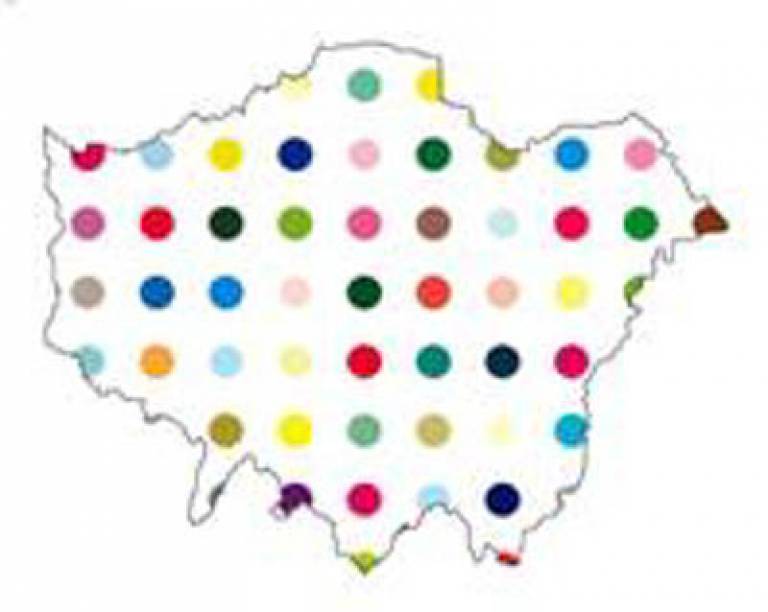Urban artscapes: revisioning contemporary London
27 May 2008, 12:00 am

Event Information
Open to
- All
Location
-
UCL Urban Laboratory
This one-day workshop, organised by Andrew Harris from the Urban Laboratory at University College London, brought together geographers, artists, planners, regeneration specialists and architectural historians to assess how London's urban geographies over the last two decades have been reshaped and reimagined through practices and urban visions associated with art.
The day was divided into four segments. The first examined the locations in London where artists have tended to live and work over the last four decades. It began with Derek Jarman's rarely screened Super-8 film, Studio Bankside (1970), which captured the everyday world of a group of artists, including Jarman, in a warehouse close to where the Tate Modern is now located. Nick Green from Manchester University then mapped the spread of artist studios across postindustrial East London from the late 1960s to the late 1990s. The session ended with an extract from The London Particular (2004), directed by Benedict Seymour and David Panos, showing how the recycling by artists of formerly down-at-heel areas of inner London such as Shoreditch has been accompanied by new processes of gentrification.
This film extract led into the second half of the morning, which considered how art and art history have been co-opted in the class-based remaking of contemporary London. Andrew Harris from UCL looked at the role of contemporary art in the promotion and consolidation of London as an archetypal 'global city' of high finance and business services at the expense of more diverse and ordinary understandings of the city. Owen Hatherley from Birkbeck dissected how art history has been used as a form of heritage in a variety of recent regeneration projects from Arsenal to Brentford and Woolwich, and how this has helped transform places of working class labour and dwelling into housing for professional elites.
The session after lunch turned to the possibilities for critical artistic interventions in this widespread gentrification of contemporary London. The artist Laura Oldfield Ford discussed her Savage Messiah zines that - reactivating a DIY post-punk aesthetic - use drawings, photomontages and personal narrative from 'drifts' around London to provide a schizoid cartographic take on the socio-political reshaping of everyday space. The artist and filmmaker Hilary Powell talked about her interventions around the 2012 Olympics site, including Olympic Spirits and Foodstuffs Ltd, a spoof company she has set up to market the last harvest of London's Olympic 'zone' from fruit gathered on the edges of the Olympic Park.
The day concluded with an exploration of how art can be used to rethink and positively re-appropriate the political and social life of contemporary London. Alex Loftus from Royal Holloway discussed the Generalized Empowerment project run in Brent and Spitalfields by a Belgium-based collective called Citymine(d). This project used artistic interventions to try and open up the everyday environment of London as both a resource and a terrain for negotiating democratic life. Finally Paul Goodwin from Goldsmiths' Centre for Urban and Community Research detailed a photography exhibition he curated in 2007 called Peckham Rising. Part of a wider agenda of 'Revisioning Black Urbanism', this exhibition challenged media representations of Peckham as symbolic of new urban pathologies by highlighting the creative energies and complex and diverse social ecologies of 'street life' in the area.
The workshop demonstrated how focusing on the intra-urban geographies of London's 'artscapes' can provide a productive means of conceiving and investigating new aspects of urban change. The consumption and celebration of London's urban landscapes has been a key feature of the city's restructuring over the past twenty years, yet there has been surprisingly little analysis of the role of London's art world in this shift - despite its dynamism, rapid growth and high media profile. The workshop's focus on urban artscapes also showed the importance of carefully drawing across a variety of disciplinary perspectives from quantitative modelling of urban dynamics to architectural history, and juxtaposing academic research with film-making and art projects. By stirring up conventional academic discussions in this way, significant cultural dimensions can be highlighted that are often overlooked in accounts of growing socio-economic and political urban inequalities. Moreover, the emphasis on art practice offers different possibilities for challenging and revisioning how contemporary cities such as London are experienced, shaped and lived.
 Close
Close

